|
|
 |
Fiche d'espèce de Copépode |
|
|
Calanoida ( Ordre ) |
|
|
|
Diaptomoidea ( Superfamille ) |
|
|
|
Acartiidae ( Famille ) |
|
|
|
Acartia ( Genre ) |
|
|
|
Odontacartia ( Sous-Genre ) |
|
|
| |
Acartia (Odontacartia) ohtsukai Ueda & Bucklin, 2006 (F,M) | |
| | | | | | | Syn.: | Acartia pacifica : Brodsky, 1948 (p.73, Pl.24: figs.1-6, F,M); 1950 (p.422, fig.299: F,M); Chen & Zhang, 1965 (p.112, Pl.49: figs.9-12); Zheng & al., 1965 (p.149, fig.70); Al-Yamani & Prusova, 2003 (p.91, figs.F,M). | | | | Ref.: | | | Ueda & Bucklin, 2006 (p.78, figs.F,M, Rem.); Moon & al., 2008 (p.61, figs.F,M); Al-Yamani & al., 2011 (p.84, 86, figs.F,M); Srinui & al., 2019 (p.83, Table 2, fig.6: phylogeny, fig.7, p.90, 91); Lee S. & al. (p.86, Table 3). |  issued from: Q.-c Chen & S.-z. Zhang in Studia Marina Sinica, 1965, 7. [Pl.49, 9-12]. As Acartia pacifica. Female (from E China Sea): 9, habitus (dorsal); 10, P5 (posterior). Male: 11, habitus (dorsal); 12, P5 (posterior).
|
 Issued from : K.A. Brodskii in Calanoida of the Far Eastern Seas and Polar Basin of the USSR. Opred. Fauna SSSR, 1950, 35 (Israel Program for Scientific Translations, Jerusalem, 1967) [p.423, Fig.298]. As Acartia pacifica. Female (from Sea of Japan): habitus (dorsal); urosome (dorsal); S5, P5. Male: habitus (dorsal); last thoracic segment and urosome (dorsal); S5, P5.
|
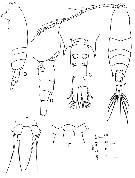 issued from : F.Y. Al-Yamani & I. Prusova in Common Copepods Northwestern Arabian Gulf : Identification Guide. Kuwait Institute for Scientific Research, 2003. [p.91, Fig.33]. As Acartia (Odontacartia) pacifica. Female: A, habitus (dorsal); B, idem (lateral left side); C, urosome (dorsal); D, idem (lateral left side); E, rostrum (ventral); F, P5.
|
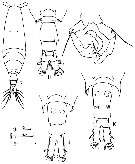 issued from : F.Y. Al-Yamani & I. Prusova in Common Copepods Northwestern Arabian Gulf : Identification Guide. Kuwait Institute for Scientific Research, 2003. [p.93, Fig.34]. As Acartia (Odontacartia) pacifica. Female: J and K, urosome (dorsal; abnormal). Male: G, habitus (dorsal); H, urosome (dorsal); I, P5.
|
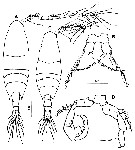 Issued from : S.E. Moon, S. Ohtsuka, H. Ueda & H.Y. Soh in Zootaxa, 2008, 1841. [p.62, Fig.1]. Female (from Gwangyang Bay); A, habitus (dorsal); B, P5. Male (from Gwangyang Bay): C, habitus (dorsal); D, P5 (r: right leg; I: left leg). Scale bars: 200 µm (A, C); 50 µm (B, D).
|
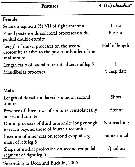 Issued from : K. Srinui, S. Ohtsuka, E.B. Metillo & M. Nishibori in ZooKeys, 2019, 814. [p.83, Table 2]. Morphological characteristics in Acartia (Odontacartia) ohtsukai from Japanese and Korean waters. Nota: Compare with Acartia (O) edentata and A. (O) pacifica/em>, closely related species.
|
 Erratum: read Srinui and not Siruanui. Female: 1 - Genital double-somite having paired posterodorsal processes. 2 - 2nd segment of A1 without strong curved processes. 3 - Exopod of P5 thickened proximally. 4 - Exopod of P5 with thickened proximal part confined to base of exopod. 5 - Length ratio of outer basal setae to exopod of P5: ca 1. Male: 1 - Urosomite 3 with large spine-like processes dorsally. 2 - Dorsal processes of urosomite 3 short, reaching posterior-most border of urosomite 4. 3 - Urosomites 3 and 4 each lacking promonenxes between pair of dorsal peocesses. 4 - Inner seta of terminal exopodal segment of left P5 longer than terminal segment.
|
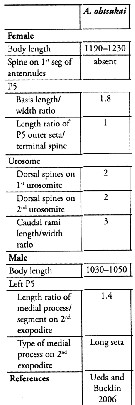 Issued from : S. Lee, H.Y. Soh & W. Lee in ZooKeys, 2019, 893. [p.84, Table 3]. Acartia (Odontacartia) ohtsukai: Morphological characters. Compare with other Odontacartia species. Nota: 1 - Absence of spine on 1st to 2nd segments of female A1 .....2. 2 - Spine present on dorsal surface of female genital double-somite ..... 3. 3 - Dorsal surface of female genital double-somite and 2nd urosomite with 2 strong spines ..... 4. 4 - Length of female P5 outer seta and terminal spine similar ...... 5. 5 - Female caudal rami 3 times longer than wide.
| | | | | Ref. compl.: | | | Ohtsuka & al., 2008 (p.115, Table 6); Moon & al., 2012 (p.1, Table 1, 2, figs.10, 11, seasonal & spatial variations); Soh & al., 2013 (p.723: Rem.); Sakaguchi & al., 2011 (p.18, Table 1, 2, occurrence Korea-Japan); Kang J.-H., 2011 (p.219, occurrences, inter-annual variability vs t° & Sal.); Suzuki, K.W. & al., 2013 (p.15, Table 2, 3, 4, estuaries, annual occurrence); Seo & al., 2013 (p.448, Table 1, occurrence); Park E.-O. & al., 2013 (p.165, Fig.5, distribution vs stations) | | | | NZ: | 3 | | |
|
Carte de distribution de Acartia (Odontacartia) ohtsukai par zones géographiques
|
| | | | | | 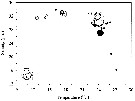 Issued from : S.E. Moon, S. Ohtsuka, H. Ueda & H.Y. Soh in Zootaxa, 2008, 1841. [p.63, Fig.2]. Issued from : S.E. Moon, S. Ohtsuka, H. Ueda & H.Y. Soh in Zootaxa, 2008, 1841. [p.63, Fig.2].
Temperature-salinity-abundance diagram for A. ohtsukai and A. pacifica.
Aundance (ind./m3) of each species is estimated by multiplying numbers on scale by 100 for A. ohtsukai (black circle) and A. pacifica (white circle).
Nota: Zooplankton samples were collected from 40 stations withn Gwangyang (southern Korea), towed vertically from the bottom to the surface layer during November 2005, and February, May and August, 2006. Specimens identified as O. ohtsukai and A. pacifica were sorted from the samples. Patterns of their occrrence were plotted on a Temperature-Salinity diagram.
The habitats of specimens as A. ohtsukai and A. pacifica in Gwangyang Bay were pronouncedly segregated.
A. ohtsukai was found in Gwangyang Bay and in adjacent coastal zone after the rainy season in late June to July when a large volume of freshwater flows into Gwangyang Bay from the Seomjin River. This inflow decreases salinity to less than 30.0 psu. In contrast, its sibling species A. pacifica occurred offshore in more than 32.0 psu. As the salinity of the regions again increased above 32.0 psu after the rainy season, A. ohtsukai was replaced by A. pacifica; at this time A. ohtsukai was restricted in its distribution to the Seomjin River estuary. Both species were absent from those areas where the water temperature was lower than 12°C. |
 Issued from : K.W. Suzuki, K. Nakayama & M. Tanaka in J. Oceanogr., 2011, 69. [p.23, Fig.5]. Issued from : K.W. Suzuki, K. Nakayama & M. Tanaka in J. Oceanogr., 2011, 69. [p.23, Fig.5].
Bubble plots of densities of the semi-endemic calanoid Acartia ohtsukai in relation to temperature, salinity, and turbidity observed in the Chikugo and Midori River estuaries (south Japan) in 2005 and 2006. |
 Issued from : J.-H. Kang in Ocean Sci. J., 2011, 46 (4). [p.228, Fig.5] Issued from : J.-H. Kang in Ocean Sci. J., 2011, 46 (4). [p.228, Fig.5]
Abundance-temperature-salinity diagram of A. ohtsukai observed in the seaports from Korea during 3 years (2007-2009). |
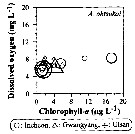 Issued from : J.-H. Kang in Ocean Sci. J., 2011, 46 (4). [p.230, Fig.7] Issued from : J.-H. Kang in Ocean Sci. J., 2011, 46 (4). [p.230, Fig.7]
Abundance-dissolved oxygen-chlorophyll-a diagram of A. ohtsukai observed in the seaports from Korea during 3 years (2007-2009). |
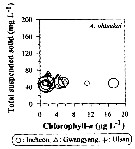 Issued from : J.-H. Kang in Ocean Sci. J., 2011, 46 (4). [p.229, Fig.6] Issued from : J.-H. Kang in Ocean Sci. J., 2011, 46 (4). [p.229, Fig.6]
Abundance-total suspended solid-chlorophyll-a diagram of A.ohtsukai observed in the seaports from Korea during 3 years (2007-2009). |
| | | | Loc: | | | Arabian Gulf (Kuwait), Japan (Rokkaku River estuary, Ariaka Bay, south estuaries), China Seas (East China Sea), S & W Korea (Gwangyang Bay, Incheon & Ulsan Harbours, Seomjin River estuary, Muan Bay, Busan), Eastern Siberia, Mouth of Amur River | | | | N: | 14 | | | | Lg.: | | | (22) F: 1,15-1,06; M: 1,01-0,95; (290) F: 1,2-1,35; M: 1-1,2; (937) F: 1,44-1,51; M: 1,26-1,33; (953) F: 1,19-1,23; M: 1,03-1,05; {F: 1,06-1,51; M: 0,95-1,33} | | | | Rem.: | Littoral.
Confondu antérieurement à 2006 avec Acartia pacifica.
Voir aussi les remarques en anglais | | | Dernière mise à jour : 09/03/2020 | |
|
|
 Toute utilisation de ce site pour une publication sera mentionnée avec la référence suivante : Toute utilisation de ce site pour une publication sera mentionnée avec la référence suivante :
Razouls C., Desreumaux N., Kouwenberg J. et de Bovée F., 2005-2025. - Biodiversité des Copépodes planctoniques marins (morphologie, répartition géographique et données biologiques). Sorbonne Université, CNRS. Disponible sur http://copepodes.obs-banyuls.fr [Accédé le 26 août 2025] © copyright 2005-2025 Sorbonne Université, CNRS
|
|
 |
 |















